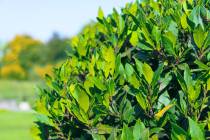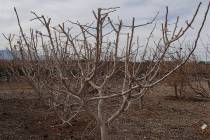Fertilizer numbers key in selecting type to use
There are several educational programs and events offered by the University of Nevada Cooperative Extension that might interest my readers or your friends.
March 5 is a big event day at the master gardener orchard in North Las Vegas. We are calling it our first ever Grape Day, and we will be discussing how to grow grapes, make wines from grapes and other fruits and how to prune grapes. On that same day we will have vegetable and herb transplants available from a local grower. The Grape Day is free to the public but the transplants will be for sale.
Later in March will be our first master food preserver classes. Our instructor, from Utah State University, will teach you how to preserve your food whether it is canning, freezing, drying or other ways of food preservation. The class will be held March 21-23 during the day at the Lifelong Learning Center, 8050 Paradise Road. Graduates will be expected to serve the community as volunteer master food preservers at public events. There is a fee for the classes.
For more information on these and other events, contact the master gardener help line at 257-5555.
I am getting a number of questions regarding what to use for fertilizing different trees, shrubs, fruit trees and palms. Answer these questions when deciding what fertilizer to use.
Is it young or recently planted? Then the focus would be focused on root growth to get it established.
Is this a mature plant where balanced growth between roots and stems is needed? Am I interested in producing fruit or flowers of any kind?
If the focus is on getting roots established, if or flowers and fruit are desired, then use a fertilizer high in phosphorus. Do not neglect nitrogen or potassium, but have them at lower levels. Look for a fertilizer high in phosphorus and moderate in nitrogen and potassium. This might be a fertilizer like 10-20-10, 8-16-6, 5-10-5 or numbers that sequence lower-high-lower. Rose and fruit tree fertilizers usually follow sequences like this.
If you desire leaves and stems, then the first number should be high followed by two low numbers. Examples might be 20-10-10, 16-8-6 and 10-5-5. Lawn fertilizers usually follow a sequence like this unless it is a new lawn that needs phosphorus for root growth.
Fertilizer manufacturers label fertilizers as "rose food" or "citrus food" because these are in the proper sequences, but most homeowners do not know how to interpret the sequences or numbers on the bag. You can substitute any fertilizer for another plant as long as you understand these principles and can read the number sequence correctly.
Remember that the first number, nitrogen, stimulates leaf and stem growth. Phosphorus, the second number, stimulates flower, fruit and root growth. The third number is potassium and it really does not stimulate anything that we can see but is important for a plant's general health and resistance to disease and stresses in general.
Now you will see how I used this information to answer the following two questions.
Q: Would you please tell me the correct fertilizer to use for a wisteria vine and trumpet vine?
A: Since these vines are valued for their flowers, but we still want strong growth and good health, then a high phosphorus and moderate nitrogen fertilizer should be used. Examples might be 10-20-10, 6-16-6, 8-16-8; 5-10-5, etc. Add an iron chelate if you saw any yellowing in the foliage during the summer months last year.
Q: Do you have any recommendations as to the type of fertilizer to use on canary palm trees?
A: I would suggest a basic tree or shrub fertilizer since these are not valued for their flowers or fruit and they are not newly planted. Some basic tree and shrub fertilizers are 20-10-10, 16-8-8, 12-4-4; just get the first number the highest. Put it around the place where water is applied to the tree, such as a bubbler or drippers.
If your palm develops yellowing during the summer, then you can apply some iron chelate such as iron EDDHA. You would apply that now if you had problems last year.
Q: I cut several twigs from my fig tree (mission) last year trying to start new plants. Sadly, none of them took. Can you help?
A: Now is a good time to take fig cuttings. When you do this, take them from last year's growth and cut this growth into stems about 8-10 inches long. Rooting hormone is not necessary but you can dip them in hormone if you want to.
Stick them into potting soil or any sterilized soil (right side up) that drains easily. Bury the cuttings upright so that half of the stem is in the soil. Keep the soil moist but not wet. It is best rooted in a warm location with plenty of indirect light but not in direct sunlight.
The cuttings should show new growth and roots in about 30 days or less. Once rooted they can be planted outside.
Bob Morris is an associate professor with the University of Nevada Cooperative Extension. Direct gardening questions to the master gardener hot line at 257-5555 or contact Morris by e-mail at morrisr@unce.unr.edu.






















